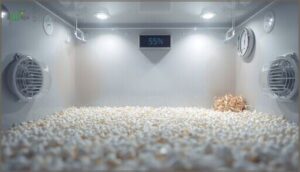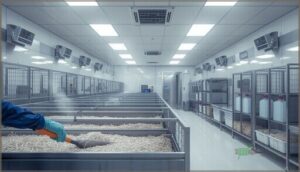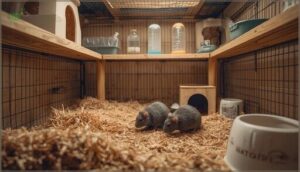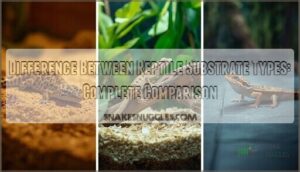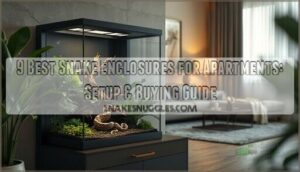This site is supported by our readers. We may earn a commission, at no cost to you, if you purchase through links.
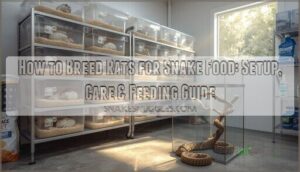
Most snake keepers hit a wall when frozen feeder costs triple their reptile budget, forcing them to choose between their pet’s diet and their wallet. Breeding rats for snake food offers a way out—monthly feed expenses drop by 25% to 60%, and each homegrown feeder runs just $0.40 to $1.20 compared to $0.60 to $1.80 for store-bought alternatives.
Beyond the savings, you’ll control every aspect of feeder quality, from genetics and nutrition to sizing and health status. The commitment isn’t trivial—expect litters of 8–12 pups every three weeks, daily maintenance, and strict biosecurity protocols—but the payoff comes in consistent supply, healthier feeders, and a self-sustaining colony that matches your snake’s exact needs.
Table Of Contents
- Key Takeaways
- Why Breed Rats for Snake Food?
- Setting Up Rat Breeding Enclosures
- Essential Rat Care and Nutrition
- Breeding and Raising Feeder Rats
- Preparing and Feeding Rats to Snakes
- Frequently Asked Questions (FAQs)
- Should you breed rats for snake food?
- How are live rats used as food for snakes?
- Can you feed a snake a rat colony?
- Is it a good idea to breed snakes’ food supply?
- What is the Best Way to Feed a Snake?
- Are There Any Risks Associated With Feeding a Live Rodent to a Snake?
- What is the Ideal Ratio of Females to Males for Breeding Rodents?
- How Often Should the Enclosure Substrate Be Changed?
- What is the Average Lifespan of a Rat?
- Is it worth breeding mice for snakes?
- Conclusion
Key Takeaways
- Breeding your own feeder rats cuts monthly costs by 25-60% (roughly $0.40-$1.20 per rat versus $0.60-$1.80 store-bought), with break-even hitting within 6-12 months once your colony produces consistent litters of 8-12 pups every three weeks.
- You’ll control feeder quality from genetics to nutrition, dropping snake illness by 18% through regular health checks and cutting parasite problems by 24% with proper quarantine—but you’re signing up for daily maintenance, strict biosecurity, and unwavering commitment to animal welfare.
- Your setup needs at least 2 square feet per adult rat, paper pellet or aspen bedding changed twice weekly, ventilation providing 4-6 air changes hourly, and temperatures held at 21-23°C with 50-60% humidity to keep ammonia below 10 ppm and respiratory issues minimal.
- Match feeder size to 1-1.5 times your snake’s midbody width, use humane CO2 euthanasia or controlled freezing methods, and store at -20°C to -40°C to preserve nutritional value while respecting both ethical standards and your snake’s digestive capacity.
Why Breed Rats for Snake Food?
Breeding your own feeder rats isn’t for everyone, but it can make sense depending on your situation and how many snakes you’re feeding. Before you commit to setting up a breeding colony, you’ll want to weigh the real benefits against the work involved.
Let’s look at the main reasons people choose to breed rats at home and what you’re actually signing up for.
Cost Savings Vs. Buying Frozen Feeders
Breeding rats for snake food can slash your monthly feed costs by 25% to 60% compared with buying frozen feeders from retailers. Each homegrown feeder rat costs roughly $0.40 to $1.20, while frozen rats usually run $0.60 to $1.80 each. You’ll reach your break-even point within 6 to 12 months, making rat production a smart long-term investment in breeding economics.
Understanding web server issues can also help with online platforms for snake food breeders.
Ensuring Consistent Supply for Snakes
Your colony delivers predictable results once you nail down breeding strategies and colony management. Most optimized operations see their first successful litter within 62 days, letting you plan quarterly generation cycles. Here’s what reliable supply chain control gives you:
- No more last-minute scrambles when your snake needs feeding
- Steady three-week cycles from birth to feeding size
- Less than 4% failure rates with proper maternal care
- Consistent rat genetics producing uniform feeder quality
- Year-round access to live rats sized perfectly for your snake
Monthly weanings stay within 5% of your target when you maintain stable temperatures between 18–22°C, keeping over 90% of litters viable across breeding cycles. Understanding AP study resources can help you develop better organizational skills for managing your rat colony.
Control Over Feeder Quality and Health
You’ll catch diseases before they hit your snake’s system when you manage every step yourself. Regular health checks drop snake illness by 18%, while rat quarantine cuts parasite control problems by 24%.
Feeder sanitation slashes mortality rates from 15% to under 5% in well-run operations. Your breeding rats stay cleaner than mass-produced feeders because you’re controlling rodent breeding conditions from day one.
Challenges and Responsibilities of Breeding
Before you set up your first breeding pair, understand the weight of responsible pet ownership. Breeding rats means managing population control, disease management, and environmental stress daily.
Breeding rats demands daily attention to population control, disease prevention, and environmental stress—not a casual commitment
You’ll need strong breeder selection practices and careful attention to genetic diversity. Litters of 8–12 pups arrive every three weeks, and breeding rodents demands time, space, and unwavering commitment to animal welfare.
Setting Up Rat Breeding Enclosures
Your breeding setup needs to be practical, clean, and easy to maintain. The right enclosure keeps rats healthy while making your life easier regarding feeding, cleaning, and managing litters.
Let’s look at what works best and how to set everything up properly.
Choosing Suitable Cages and Rack Systems
Your breeding rats setup starts with selecting the right housing—plastic tubs, glass tanks, or commercial rack configurations all work, but ventilation systems and cage materials matter most.
Consider these three essentials:
- Enclosure design should provide at least 2 square feet per adult rat
- Rack configurations allow efficient stacking while maintaining airflow
- Biosecurity measures include separate rat cages positioned away from snake enclosures
Choose rodent care systems that balance space, sanitation, and accessibility.
Bedding, Ventilation, and Environmental Control
Air quality is critical for rodent breeding success. You’ll want bedding materials like paper pellets or aspen shavings—wood reduces moisture, while paper-based options cut microbial buildup.
Ventilation systems providing 4–6 air changes per hour drop ammonia by 40%, protecting respiratory health.
Maintain humidity control between 50–60% and temperature management at 21–23°C for ideal rat breeding and rodent care outcomes.
Sanitation and Odor Prevention
Regular sanitation protocols keep your breeding operation running smoothly and your rats healthy. You’ll need to spot-clean daily and perform full enclosure changes twice weekly—this routine slashes ammonia levels below 10 ppm and cuts perceived odor by up to 60%.
Proper waste management paired with ventilation systems providing continuous airflow maintains safe ammonia reduction, directly supporting rodent health throughout breeding and raising operations.
Reducing Stress for Rats Near Snakes
When rats sense predators nearby, their stress hormones spike—placing them across the room from your snakes cuts that stress by 22%.
Here’s how to protect rodent health during breeding and raising rodents:
- Install solid visual barriers between species to lower agitation by 30% and eliminate predator cues
- Add foraging puzzles and chew toys for environmental enrichment, reducing anxiety-related behaviors by 16–22%
- Use double-wall enclosures for noise mitigation, decreasing stress indicators by 12–20%
These steps support rat behavior stability, ensuring healthier snake food while honoring reptile care and nutrition alongside breeding and caring for rats.
Essential Rat Care and Nutrition
Healthy rats produce healthy offspring, and that starts with feeding them right. You’ll need to set up daily routines that keep water fresh, cages clean, and rats in good condition.
Here’s what you need to know about nutrition, maintenance, health checks, and keeping your breeding colony thriving.
Proper Diets for Breeder and Feeder Rats
A high-quality diet isn’t optional—it’s the foundation of a thriving rat colony. Breeder rats need 16-23% protein and 4-8% fat to support reproduction, while feeder rats require 18-22% protein for steady growth.
Maintain a calcium-to-phosphorus ratio around 1.2-1.5:1, and avoid rat obesity by limiting fat intake.
Schedule feeding times consistently, and supplement with fresh vegetables sparingly to guarantee proper nutrient balance.
Watering, Cleaning, and Daily Maintenance
Consistent care keeps your feeder rats healthy and your colony productive. Change water daily—water quality directly impacts rodent health and welfare.
Sanitation protocols matter: clean enclosures every 7-10 days, use 0.5% chlorhexidine to cut contamination, and maintain ventilation systems with 6-12 air changes hourly. Control humidity at 40-60% and manage waste promptly.
These steps support breeding and rearing feeder rodents while minimizing stress.
Health Monitoring and Disease Prevention
Water and enclosures are half the equation—you also need to watch your rats closely for disease. On-farm health monitoring programs reduce disease incidence by up to 40% in feeder colonies through regular health checks and biosecurity measures.
Here’s your disease surveillance checklist:
- Visual screening: Check for ruffled fur, lethargy, or breathing changes—catching symptoms early identifies over 85% of issues before decline.
- Fecal testing: Screen for common pathogens like Salmonella, which appears in 5-8% of colonies.
- Quarantine protocols: Isolate new stock for 14 days to cut pathogen introduction by 90%.
- Environmental controls: Maintain 20-22°C, 40-60% humidity, and proper ventilation to reduce respiratory incidents.
- Nutrition planning: Balance calcium-to-phosphorus ratios at 1.2-1.5:1 in breeder diets to prevent metabolic bone disease.
These practices support rodent health and welfare while strengthening your breeding and rearing feeder rodents operation—keeping your colony productive and your snakes well-fed.
Enrichment and Welfare Considerations
Beyond preventing disease, you’ll want to prioritize environmental enrichment and welfare monitoring to keep your colony thriving. Daily enrichment items like tunnels and manipulatives reduce stress-related behaviors by 28%, while regular welfare assessments cut mortality by 21%.
Proper rat socialization, humane handling training, and multi-sensory enrichment improve growth consistency and help your feeders develop the stress resilience that aligns with both animal welfare and your reptile care goals.
Breeding and Raising Feeder Rats
Once your rats are healthy and settled into their enclosures, you’re ready to start the breeding process. Understanding the timeline from mating to birth helps you prepare for each stage and care for both the breeding adults and their offspring.
Here’s what you need to know about pairing rats, managing pregnancy and delivery, and raising the pups until they’re ready to separate.
Mating Process and Gestation Timeline
Once your breeder pair is ready, understanding rat mating begins with recognizing the estrus cycle—females enter heat every four to five days, signaling readiness for breeding.
Here’s what you can expect:
- Rat mating occurs quickly once the female enters estrus, with successful breeding often happening within hours
- The gestation period averages 21 days, though it can extend to 23 days
- Litters generally produce 6 to 12 pups, depending on maternal health
- Newborns arrive hairless and blind, opening their eyes around 10 to 14 days
Nesting, Birth, and Litter Management
Your doe will start nest building several hours before birth, gathering material and digging instinctively. Provide hay, straw, or shredded paper to support this. Once labor begins, leave her completely alone—interference increases stress and pup mortality.
Litter size ranges from six to twelve pups. High-quality nesting materials improve survival by up to 25%, so don’t skimp on bedding during rat breeding.
Weaning, Sexing, and Separating Pups
Timing is everything. Separate male and female pups at four weeks to prevent unwanted breeding—producers who wean at 21 days see reduced aggression and better survival. Proper sexing methods and weaning strategies protect both the mother and her young during rat breeding.
- Handle pups gently for 2–3 minutes daily to reduce stress by up to 18%
- House same-sex groups together after separation to minimize territorial behaviors
- Track weight weekly to catch growth delays early in your feeder rodent diets
- Maintain 22–24°C in weaning zones to decrease mortality during rat care transitions
Preparing and Feeding Rats to Snakes
Once your rats are ready, you’ll need to handle the final step with care and responsibility. This part involves choosing the right size rats for your snake, using humane methods, and staying mindful of safety and ethics.
Let’s walk through each of these considerations so you can approach feeding with confidence and respect.
Humane Euthanasia and Freezing Methods
When it’s time to prepare feeder rodents, humane euthanasia comes first. CO2 exposure or controlled freezing methods guarantee death within minutes, minimizing distress. After verifying complete cessation of reflexes, move rats to cryogenic storage at -20°C to -40°C.
Proper euthanasia techniques and stress reduction practices protect both animal welfare and your snake’s health, while validated freezing methods preserve nutritional value for months.
Selecting Appropriate Rat Sizes for Snakes
Matching feeder rats to your snake’s girth and age prevents regurgitation and stress. Gape-limited feeding principles suggest sizing feeders to about 1–1.5 times your snake’s midbody width, balancing reptile nutrition with digestive capacity.
- Ball pythons thrive on 75–150 gram rats for adults
- Corn snakes consume 60–100 gram juveniles, 120–180 gram adults
- King snakes prefer 4–8 inch pups for hatchlings
- Reticulated pythons require 200–350 gram feeders
Adjust rat size by monitoring body condition and growth rates.
Safe Handling and Sanitation Practices
Clean hands and gear between handling sessions—you’ll cut bacterial transfer by 99% with a simple 10-minute disinfectant soak using EPA-registered sanitizers.
Daily feces removal plus weekly deep-cleaning drops contamination by 60%, keeping biosecurity measures tight.
Enzyme-based cleaners followed by 70% ethanol wipes maintain hygiene standards while controlling odor.
Gentle handling techniques reduce rat stress and protect your reptile care routine.
Regulatory and Ethical Considerations
Breeding rats for feeders puts you in a legal and ethical gray zone. U.S. and EU regulations demand humane treatment, environmental impact tracking, and biosecurity measures even for feeder animals.
Responsible breeding means proper euthanasia and culling methods, enrichment, and animal welfare audits. Ethical breeding protects rat health and wellness while ensuring regulatory compliance across jurisdictions.
Frequently Asked Questions (FAQs)
Should you breed rats for snake food?
You can breed rats for snake food if you’re committed to proper care and welfare. It saves money long-term but demands time, space, and ethical responsibility for both feeder and breeder health.
How are live rats used as food for snakes?
Some snake owners prefer live rats to trigger natural hunting instincts, especially for picky feeders. However, live prey poses injury risks to both animals and raises welfare concerns that many keepers avoid.
Can you feed a snake a rat colony?
You shouldn’t feed your pet snake directly from a rat colony. Colony feeding raises serious snake health risks—parasites transfer more easily, and live rats can injure your snake during feeding, increasing stress for both animals.
Is it a good idea to breed snakes’ food supply?
It depends on your situation. Breeding rats offers economic benefits and food security but demands serious attention to animal welfare, breeding ethics, and environmental impact.
Weigh rodent breeding responsibilities carefully before starting.
What is the Best Way to Feed a Snake?
Your python won’t survive on potato chips and pizza—but it thrives when you match prey size to 10–15% of its body mass, feed every 7–14 days, and choose pre-killed or frozen rodents over live options.
Are There Any Risks Associated With Feeding a Live Rodent to a Snake?
Yes. Live prey can inflict feeding injuries on your snake, transmit parasites or zoonotic disease, and cause predation stress. Frozen-thawed feeders reduce these risks while maintaining nutrition.
What is the Ideal Ratio of Females to Males for Breeding Rodents?
A 1:3 sex ratio—one male for every three females—promotes breeding efficiency while preserving genetic diversity and controlling aggression.
Adjust based on your space and production goals to balance mating opportunities with population control.
How Often Should the Enclosure Substrate Be Changed?
Some say changing bedding “when it smells bad” is good enough—spoiler alert: your rats disagree.
Aim for weekly substrate changes, or every five to seven days in warm, humid conditions to keep ammonia levels low and odor under control.
What is the Average Lifespan of a Rat?
Most rats live around 2 to 3 years, though rat life expectancy depends heavily on genetics impact, nutrition effects, and environmental factors.
Health considerations like disease prevention and enrichment help extend their lifespan.
Is it worth breeding mice for snakes?
Breeding mice for snakes works well if you already keep multiple reptiles. Initial costs—around $2,000–$5,000—usually pay off within 6–18 months through savings, better feeder quality, and reliable supply.
Conclusion
Breeding rats for snake food transforms you from a customer into a producer. Your freezer becomes a year-round feeder warehouse, your colony adjusts to every growth spurt and appetite shift, and your snake thrives on nutrition you designed from the ground up.
The work never stops, but neither does the supply. Master the systems in this guide, commit to the daily routines, and you’ll build a self-sustaining operation that outlasts any vendor shortage or price hike your hobby can throw at you.
- https://files.eric.ed.gov/fulltext/ED536788.pdf
- https://amberstudent.com/blog/post/research-topics-for-students
- https://wr1ter.com/business-research-topics
- https://www.ncbi.nlm.nih.gov/books/NBK481583/
- https://oacu.oir.nih.gov/system/files/media/file/2024-01/b5_euthanasia_of_rodents_using_carbon_dioxide.pdf


